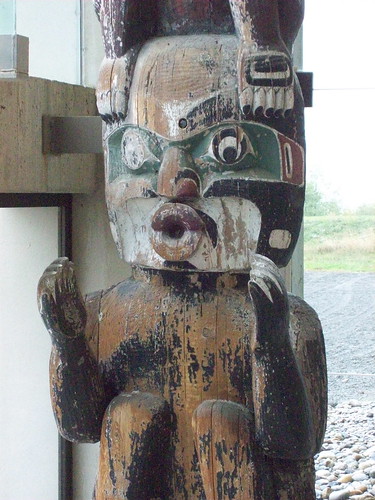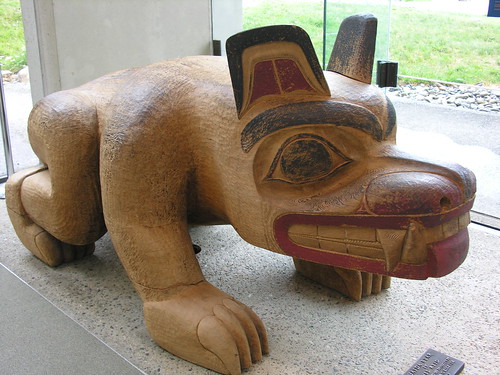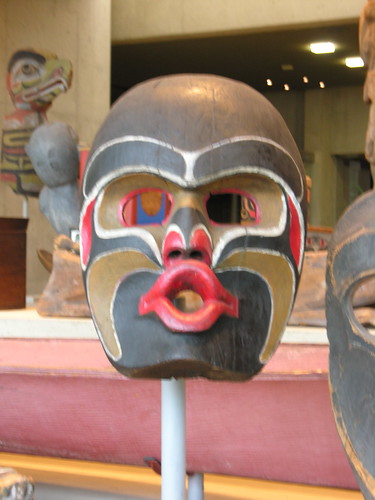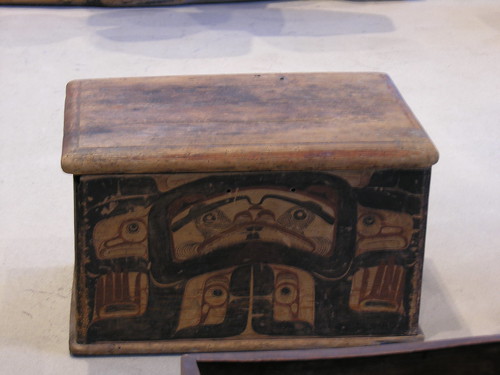Travel to University of British Columbia Museum of Anthropology
Posted in Art, Canada, Family Fun, Historic, Museums, Travel | By Roger Gillespie | Tags: Anthropology, Art, First Nations, Historic, Museum, Travel, Vancouver
If you are interested in Totem Poles (and who isn’t?), you have two distinct possibilities to see them firsthand in Vancouver. B.C. One option is “free” near the entrance of Stanley Park (see our September 28 blog). The constant rumbling of tour buses stopping in the parking area is an interesting juxtaposition of ancient cultural and modern forms of pollution …
I’m sure the original First Nations population of British Columbia would have been appalled, or at least confused by the throngs of tourists snapping photos and taking videos of the assembled collection of Totem Poles in the park.
The other option for seeing Totem Poles and other collections of First Nations art is not free, but without the tour buses.
Approximately 20 minutes from downtown Vancouver, and an interesting drive through the suburban area of south Vancouver, is a quieter and reserved observation of the creations of the First Nations peoples.
(First Nations – - – refers to the over 600 aboriginal bands of peoples of Canada.)
A large collection of over 35,000 artifacts are housed at the Museum of Anthropology (MOA) located on the campus of the University of British Columbia. Today’s building is far more complex than its humble beginnings in 1949 in the basement of the University Library.
The current museum was designed and built in 1976, holding collections of not only First Nations artifacts, but that of the South Pacific, Asia, Africa, Europe and the Americas.
Most well-known for its Northwest Coast collections, the MOA exhibits large sculptures in the Great Hall.
These large wooden sculptures of red cedar are representative of several First Nations communities such as the Haida, Kwakwaka’wakw, and Oweekeno.
Even a thousand years ago, guys were telling fish stories…

"Really guys! The fish was THAT big!"
A more modern sculpture, the Haida Bear is representative of recent First Nations work.

Haida Bear by Bill Reid
As you enter the galleries just past the guest services desk, you descend The Ramp which also features large sculptures grouped by culture/community area on either side. The Coast Salish communities near the top of the ramp moving down to more northern groups such as the Haida.
A large number of the larger sculptures on either side of the ramp were once parts of the cedar plank houses where families lived. Serving as supports for roof beams or as decoration in, or outside the house, the sculptures usually represented ancestors that were historically linked with the inhabitants.
About 1900, the most vivid of the ceremonial feast dish covers (below) was created in Kingcom Inlet, British Columbia. It is carved from red cedar.

Ceremonial Feast Cover
This box (below) was created both for storage and as an heirloom in its own right. The sides were bent from one piece of wood with steam, then colored with mineral-based pigments. Red came from hematite; black was derived from magnetite. The pigments were then mixed with a binder of ground and chewed salmon eggs!

One piece of wood was steam bent to form the sides of this heirloom box
Unfortunately, the large open storage area is currently in renovation, scheduled to open in January 2010. A $55.5 million project dubbed the “Multiversity Galleries” will make nearly 15,000 objects visually accessible to museum goers.
Along with the permanent exhibits, temporary exhibits are scattered throughout the museum.
So, although not as complete an immersion into First Nations culture as I would have liked, due to the renovation, I was still impressed. And if I were a beaver, or a woodchuck … I would have been HIGHLY impressed by all of that wood in the Great Hall!
HOURS
Summer:
Mid-May through Mid-October
Daily 10 am to 5 pm; open Tuesdays 10 am to 9 pm
Winter:
Mid-October through Mid-May 2010
Mondays: Closed
Tuesdays: 10 am to 9 pm
Wednesday – Sunday: 10 am to 5 pm
ADMISSION
Adults $11.00 (CD)
Students & Seniors (65+) $9.00 (CD)
Family (2 adults & up to 4 children -18) $30.00 (CD)
Tuesday evenings 5-9 pm Flat rate $6 (CD) (groups included)
Children 6 and under Free
Tomorrow… Come back to learn about a place with 38 flavors of ice cream and a fun time…
Tags: Anthropology, Art, First Nations, Historic, Museum, Travel, Vancouver
